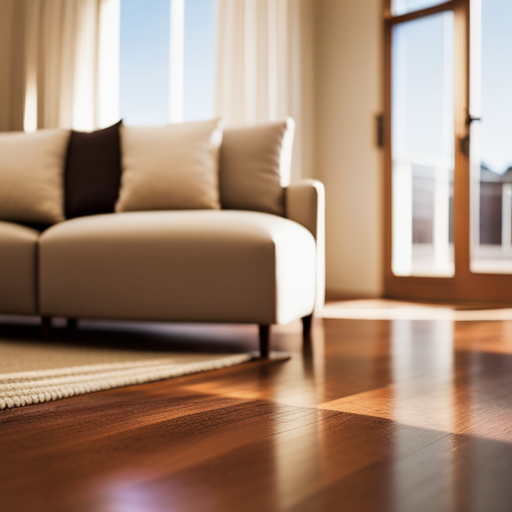The Impact of Flooring on Home Insurance Premiums

Putting your best foot forward in home design can have a surprising impact on your insurance premiums. The flooring choices you make for your home can significantly influence the cost of your insurance coverage.
Understanding the relationship between flooring and insurance is essential for homeowners seeking to make informed decisions about their investments and risk management.
In this article, we’ll explore the intricate connection between flooring types and home insurance premiums, along with tips for optimizing your coverage.
Types of Flooring and Insurance Costs
One of the primary factors that influence home insurance premiums is the type of flooring installed in a property. When it comes to laminate vs hardwood, and carpet vs tile, the choice of flooring can significantly impact insurance costs.
Hardwood floors are often perceived as more durable and resistant to damage compared to laminate flooring. As a result, homes with hardwood floors may be eligible for lower insurance premiums due to the reduced risk of damage from common issues such as water leaks.
On the other hand, carpeted floors may pose a higher risk for water damage and mold growth, potentially leading to higher insurance premiums compared to homes with tile flooring, which is more resistant to water damage.
Insurance companies also consider the maintenance and longevity of different flooring types. Hardwood and tile floors are generally easier to maintain and have a longer lifespan compared to laminate and carpet, which could result in lower insurance premiums due to decreased risk of claims related to wear and tear.
Therefore, homeowners should carefully consider the type of flooring they install as it can have a tangible impact on their home insurance costs.
Factors That Influence Premiums
Factors influencing premiums include the material durability and resistance of the flooring, as well as its maintenance requirements and longevity. When it comes to home insurance premiums, several factors play a crucial role in determining the cost. These factors include:
-
Property Condition and Age: The overall condition and age of the property can significantly impact insurance premiums. Older properties or those in poor condition may pose a higher risk, leading to increased premiums.
-
Location and Crime Rates: The location of the property, especially in areas with higher crime rates, can influence insurance costs. Properties in high-crime areas are at greater risk of theft or vandalism, leading to higher premiums.
-
Flooding and Natural Disasters: Properties located in flood-prone or disaster-prone areas may face higher insurance premiums due to the increased risk of damage.
-
Home Security Measures: The presence of security measures such as alarm systems, deadbolts, and security cameras can impact premiums positively by reducing the risk of theft or damage.
Understanding these factors is essential for homeowners seeking to manage their insurance costs effectively.
Transitioning to the subsequent section about ‘tips for lowering insurance expenses’, homeowners can implement strategies to mitigate these influences and potentially reduce their insurance premiums.
Tips for Lowering Insurance Expenses
Implementing cost-effective security measures can help homeowners reduce their insurance expenses while ensuring the protection of their property.
There are several cost-saving strategies that homeowners can employ to lower their insurance premiums. Installing security systems such as burglar alarms, smoke detectors, and deadbolt locks can make homes less susceptible to theft, fire, and other risks, potentially qualifying homeowners for policy discounts. Insurance providers often offer discounts to homeowners who invest in these preventive measures as they reduce the likelihood of claims, thereby saving the insurance company money in the long run.
Additionally, some insurance companies offer discounts to policyholders who have made certain home improvements, such as replacing old plumbing or electrical systems, which can reduce the risk of water damage and fire hazards.
In addition to security measures, maintaining a good credit score and bundling insurance policies with the same provider can also lead to reduced premiums. Reviewing and adjusting coverage limits, deductibles, and policy options with an insurance agent can help homeowners identify potential areas for cost savings without compromising the level of protection for their homes.
Impact of Flooring Upgrades
The flooring material used in a home can significantly influence its insurance premiums. When considering flooring upgrades, it’s essential to understand how different flooring materials can impact home insurance premiums.
Here’s how various flooring materials and renovation impact can affect insurance premiums:
-
Hardwood Flooring: Renovating with hardwood flooring is likely to increase the overall value of the home, potentially leading to higher insurance premiums due to the increased replacement cost.
-
Laminate Flooring: While laminate flooring can enhance the aesthetics of a home, it may not significantly impact insurance premiums due to its lower replacement cost compared to hardwood.
-
Tile Flooring: Renovating with tile flooring, especially in areas prone to water damage such as kitchens and bathrooms, may lead to lower insurance premiums due to its durability and resistance to water damage.
-
Carpet Flooring: Upgrading to carpet flooring may have minimal impact on insurance premiums, but it’s essential to consider the potential for increased premiums if the carpet is located in areas prone to water damage or mold.
Insurance Coverage for Flooring Damage
One key consideration when assessing insurance coverage for flooring damage is the extent of protection provided by the policy.
In many cases, home insurance policies cover flooring damage caused by specific perils such as fire, vandalism, and certain types of water damage.
When it comes to water damage claims, policies may differ in their coverage for repairing versus replacing flooring.
Some policies may only cover the cost of repairing the damaged flooring, while others may provide coverage for the full replacement cost, depending on the extent of the damage and the terms of the policy.
It’s important for homeowners to carefully review their insurance policies to understand the specific coverage and limitations related to flooring damage.
Additionally, homeowners should be aware that certain types of water damage, such as that resulting from floods or sewer backups, may require separate insurance coverage or endorsements.
Understanding the details of insurance coverage for flooring damage can help homeowners make informed decisions and take necessary steps to protect their investment in their home.
Frequently Asked Questions
Can Flooring Upgrades Affect the Resale Value of a Home And, in Turn, Impact Insurance Premiums?
Flooring upgrades can significantly boost the resale value of a home, influencing insurance premiums. Factors like damage-prone locations, age, and type of flooring impact premiums. Insurance discounts may be available for certain flooring types.
Are There Specific Types of Flooring That Are More Prone to Damage and Therefore May Result in Higher Insurance Premiums?
Certain flooring materials may pose potential risks for damage, impacting insurance coverage and maintenance costs. Factors such as susceptibility to water damage or wear and tear can influence premiums. Understanding these nuances is crucial for homeowners.
How Does the Location of a Home Affect Insurance Premiums in Relation to Flooring Types?
The location of a home can significantly impact insurance premiums. Factors such as local weather patterns, crime rates, and proximity to emergency services can influence costs. Additionally, the type of flooring materials used may also affect insurance premiums.
Are There Any Insurance Discounts Available for Homeowners Who Install Certain Types of Flooring?
Insurance discounts for homeowners who install certain flooring materials are available. These discounts are based on the impact on coverage, installation process, and the durability of the flooring. Factors such as fire resistance and water damage prevention are considered.
How Does the Age of a Home and Its Flooring Impact Insurance Premiums?
When assessing home insurance premiums, factors such as the age of the property and the materials used for flooring are considered. Renovations, including flooring upgrades, may impact insurance coverage and associated costs.
Conclusion
In conclusion, the impact of flooring on home insurance premiums is significant. The type and quality of flooring can influence insurance costs, and homeowners should consider this when selecting flooring materials.
By making informed choices and maintaining their flooring, homeowners can lower insurance expenses. Upgrading flooring can also affect insurance coverage for damage.
Just as a solid foundation supports a sturdy home, wise flooring choices can support financial stability and peace of mind.

Rubin Everest, a seasoned expert in the world of flooring, brings a wealth of knowledge and passion to the surface. As the mind behind ebbow.com, Rubin is dedicated to sharing insights on the latest trends, innovative solutions, and expert advice in the realm of flooring. Whether you’re seeking practical tips for installation or design inspiration, Rubin Everest is your go-to source for all things flooring-related, making your journey to the perfect floor an informed and enjoyable experience.





